
To be completely honest, I’m rooting for Gangs of Sherwood. This is a compact, fun, well-paced experience that is enjoyable alone or with others. The game gets a number of important things right. That being said, this game also gets plenty of things wrong. Though nothing flat out ruins the experience for me, the negatives hold back this average game from being great.
Gangs of Sherwood is a co-op action shooter/brawler that pulls from the legend of Robin Hood, the fabled nobleman-turned-vigilante of the same name. The game follows the story of Robin and his three accomplices: Marian, Little John, and Friar Tuck. Each character must use their special capabilities to free the kingdom from the tyrannical grasp of the Sheriff of Nottingham and his army of goons. Only this time, the Sheriff possesses a rare gem called the Philosopher’s Stone, which sped up technological advancement in England by some 400 years. The gang must journey across the kingdom and go face-to-face with futuristic soldiers, automatic weapons, and giant cannons in order to liberate their people.
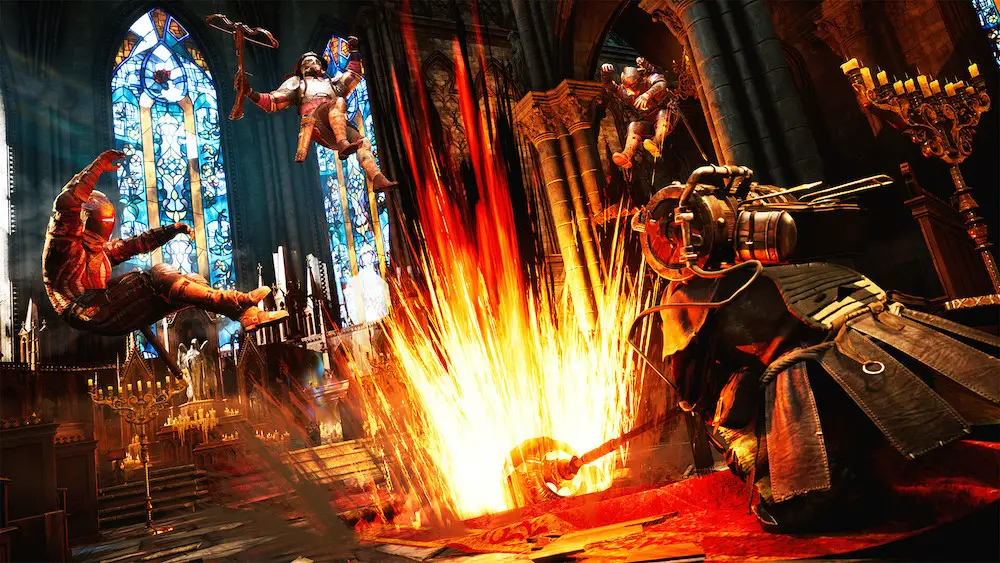
The story of Gangs of Sherwood revolves around our four characters and their feud with the current establishment, at the head of which is the Sheriff. Using Major Oak, a giant, hollowed oak tree, as a base of operations, the gang jumps from location to location to combat the enemy. There is really not much in the way of narrative here; the Sheriff is bad, his lieutenants are also bad, his army is – you guessed it – quite bad, so everybody’s got to die. The main story is conveyed mostly through dialogue between the four heroes and occasionally their enemies. One aspect of the story I appreciated was the pre-mission loading screen. Before each mission, Alan-A-Dale, the gang’s flamboyant jester friend, puts on a puppet show describing the gang’s next moves. These serve as a unique introduction, both catching the player up on the story and providing some cheap laughs.
The main campaign consists of nine linear missions throughout three settings: a lush, green forest, an ore mine/fortress, and a battleground in and surrounding the Sheriff’s castle. Unfortunately, these are largely corridor crawls made up of nearly identical combat scenarios broken up by some light platforming sections and thread-bare exploration. There are only a few set piece moments throughout the entire campaign, such as a fight at the foot of a massive artillery cannon shelling a nearby city. Though these are pretty spectacular when they happen, they’re just too few and far between to be notable. Games with short campaigns can sometimes rely on bombastic set pieces to be memorable, like say Call of Duty or Darksiders story missions. If these moments had a bigger impact in Gangs of Sherwood I would’ve been much more satisfied than I was. Nevertheless, the story was well-paced and contained some dumb fun.
At first, I was also incredibly jarred by the choice of setting for this game. I felt that it was a bizarre choice to set Robin Hood in what is essentially a World War I backdrop. Fights take place in trenches, the opposition uses chemical weapons, and enemies fight using gatling guns. However, the inclusion of the Philosopher’s Stone made sense to me, and ultimately the setting grew on me. The Sheriff’s army uses powered spears and shields and fights with advanced machinery, from armored battle suits to four-legged spider tanks. I appreciated the creative freedom on display here, especially since it adds some new life to a pretty played-out fable.
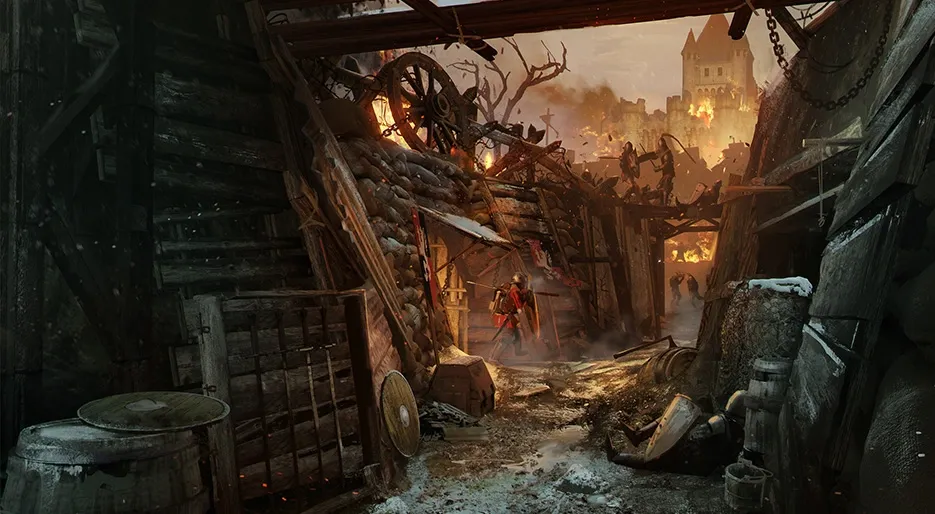
While the setting checks out, the overall tone does not. One minute the characters are quipping at each other, dashing around and making enemies look like goofballs. The next, families are hanging on trees, bloodied and battered at the hands of the Sheriff. This stark tonal contrast confuses me; I cannot tell if the game wants to be serious or silly. I think the commitment to a single tone, preferably the light-hearted one (which the game nailed in my opinion) would have worked better. Instead, it settles for an awkward edgy-funny hybrid.
Gameplay in Gangs of Sherwood is fairly one-dimensional. There is really one thing to do in this game: play through story missions. There is also a very forgettable wave-based mode. As previously mentioned, missions are interspersed with plenty of combat encounters, some easy platforming, and a tiny bit of exploration. Exploration in Gangs of Sherwood is contained to branching paths that usually lead to bonus chests full of gold or a temporary upgrade. The four characters are each able to access different kinds of branching paths depending on their stature; Robin and Marian can squeeze through tight corridors to reach hidden areas, while Friar Tuck and Little John can smash through walls or break large debris piles to uncover secrets. Some side objectives can be completed by exploring as well, like freeing a set number of prisoners.
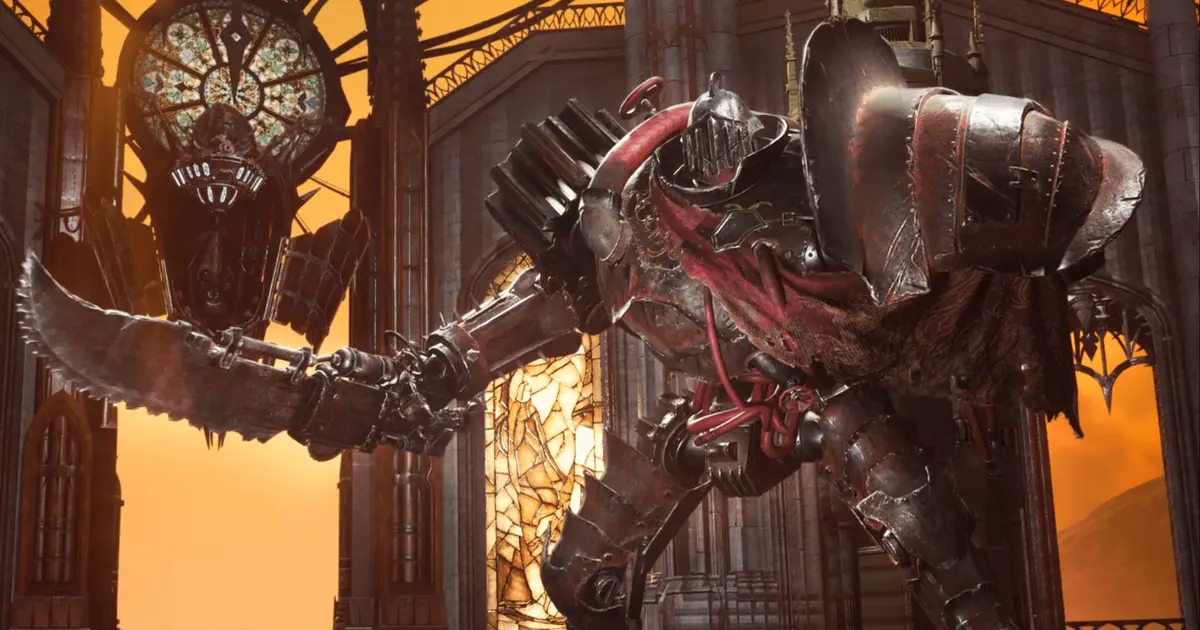
Platforming is just as straightforward as exploration. Each character is equipped with a grapple that can attach to predetermined grapple points throughout levels. More often than not, each platforming section is a series of jumps, dashes, and grapples that must be completed to either close a gap or reach a new height.
The highlight of the gameplay loop of Gangs of Sherwood is undoubtedly the combat. Combat is where each member of the gang fully differentiates, so experimentation is encouraged. Each character possesses a suite of unlockable abilities that, when used together, can cause pure devastation. For my story playthrough I played as Robin, the mid-to-long range archer class. Robin is able to keep his distance in fights and pick enemies off using his bow. Consecutive hits build a combo meter towards special moves activated by Star Arrows, special homing arrows that deal increased damage and varying effects based on what you have equipped. Some of these attacks launch enemies into the air, while others serve as destructive homing or drill arrows. I really enjoyed working my way through Robin’s character tree, collecting gold throughout missions to unlock new combos and Star Arrow abilities. Each upgrade improved how I played and let me develop a focused build centered on continuous damage between different targets.
I briefly tried the other characters as well, using the test arena provided in Major Oak that is accessible between activities. Marian is the typical rogue class, with a kit focused on dealing massive damage to single targets. Friar Tuck is a heavy melee and healer type class, with abilities centered around support and close quarters combat. Finally Little John is the brute, concentrating on battlefield control and rapid attacks. Though Robin remains my favorite, I appreciate what each character brings to the table and can see the potential they have as a team. Character designs, like the art design, are fantastic – every hero, enemy, and boss fits the setting perfectly and is a visual treat. In terms of enemy variety, there are really only a few types of baddies to fight. Standard foot soldiers and some slightly larger units will make up the bulk of every combat scenario, with many recycled bosses and mini-bosses thrown in. The enemies on offer are not the most interesting foes; however, they do make great punching bags.
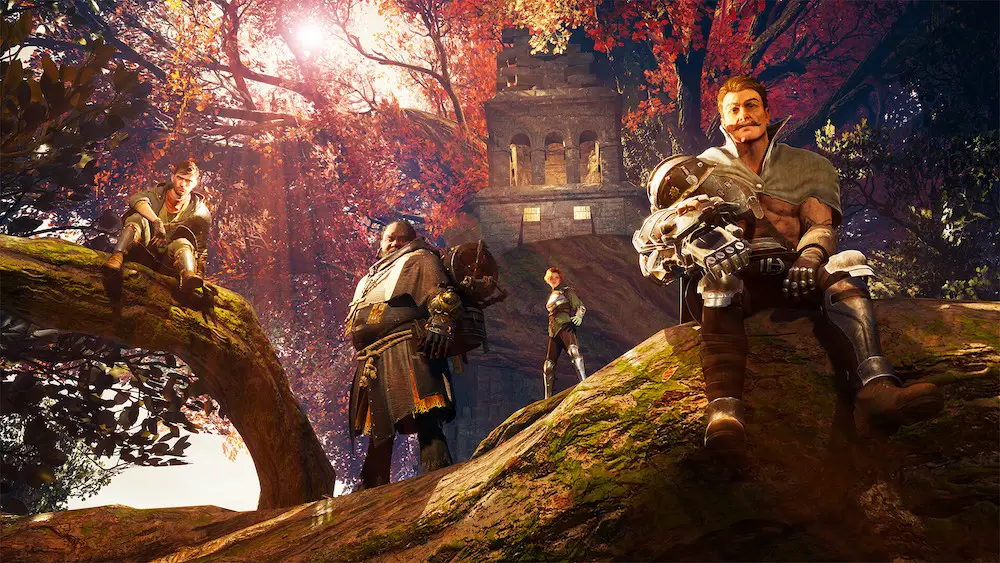
The game positions itself as a co-op action adventure and I can see why; Gangs of Sherwood is undeniably better with friends. I largely played this game solo, but when I used the matchmaking feature and connected with other players I enjoyed each fight so much more. Complimentary combat abilities and a basic ping system allow complete strangers to work together to conquer even the toughest foes. Though I only got to play with a full four-person team, or gang, once, it was easily the most fun I had. Admittedly, it was hard to get matchmade with other players. Don’t get me wrong, solo play is still a good time – but I think playing with friends is the way to go.
Speaking of easy – this game is not hard. I was honestly shocked at how little I struggled in every encounter, including the late game boss battles and enemy-dense areas. I played through the entire campaign on hard, the highest of the three difficulty types currently in the game, and died less than five times. Now I’m no professional capital G gamer, but I think that is a bit ridiculous. Though Gangs of Sherwood never positions itself as an intense challenge, I think turning the difficulty dial up just a little would surely add to the experience.
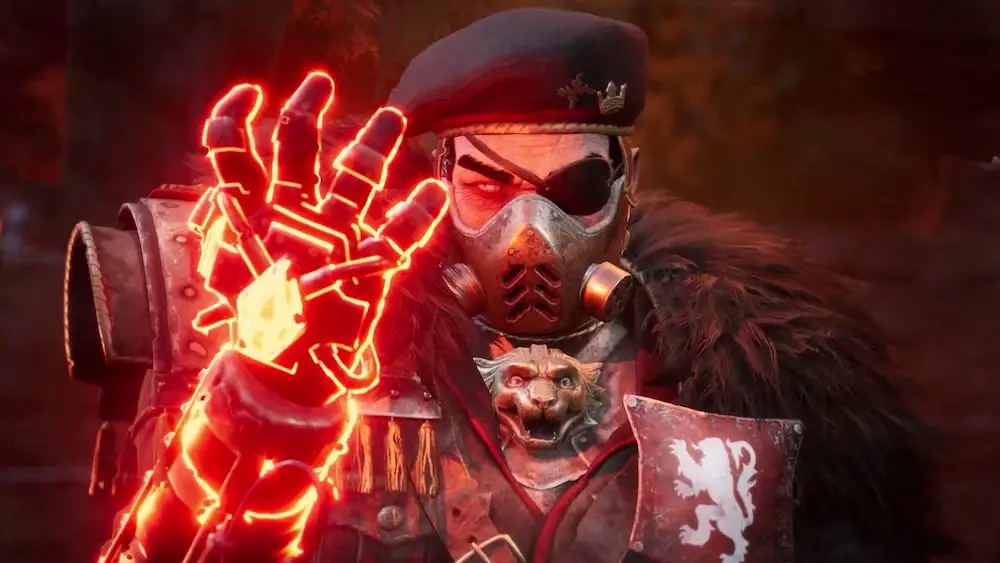
Performance on PlayStation 5 was very smooth. Rarely did I ever have any stutters or graphical glitches of any kind, and I was satisfied with sound design and the soundtrack (though nothing really stood out). Gangs of Sherwood is also no doubt a pretty game, pushing Unreal Engine 4 to its limits. Monetization is also not a thing here. There are a few skins available to purchase with real-world cash but nothing is forced, which I appreciate.
My time with Gangs of Sherwood was a fairly positive experience. Though I believe this game gets some of the fundamentals wrong, I walked away satisfied.
Gangs of Sherwood
All Right
Gangs of Sherwood offers an enjoyable and silly co-op action experience that mostly gets things right.
Pros
- Engaging classes and combat
- Interesting setting
Cons
- Not much to do
- Very, very easy
